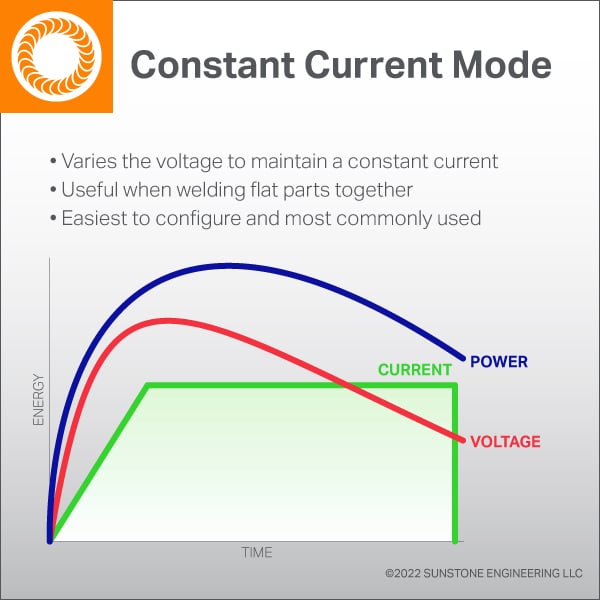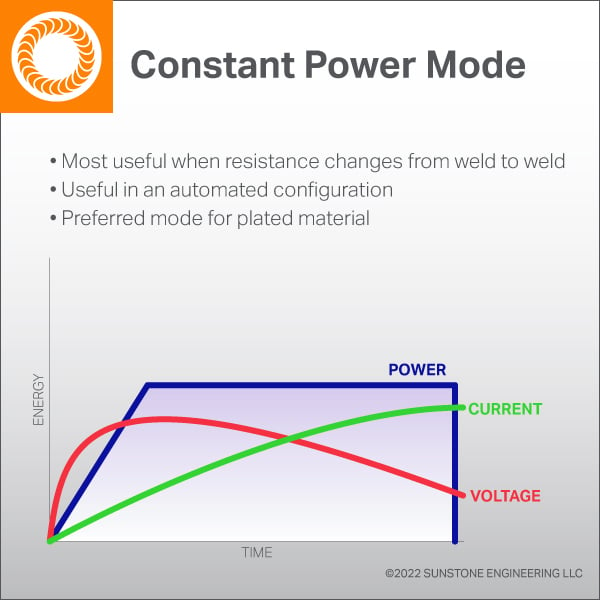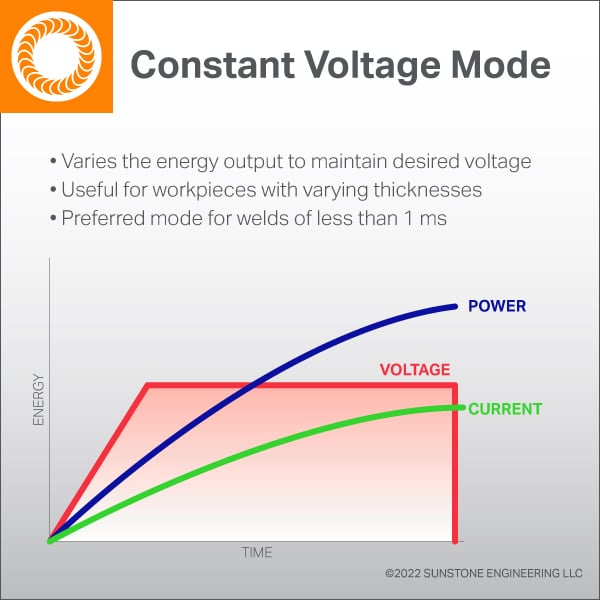HF Power Control Modes and How They Work

Thane Kennedy
Product Manager
With a high frequency inverter welder, such as the Sunstone Aeon HF, you can control energy using three distinct control modes: Constant Current, Constant Power, and Constant Voltage. The ability to control how energy flows from the welder to the workpiece will result in more consistent, high-quality welding results when working with different metal types and configurations.
In this article, the three control modes will be discussed in depth with an explanation of when one mode may be more suited for a particular application than another. If your application is unaddressed in this article, please speak with a Sunstone micro welding consultant. Text or call +1 801-658-0015. Also see 10 reasons why HF inverter technology may be a better fit for your manufacturing process than any other welding technology.
When to Weld with a Constant Current
If you switch your high frequency inverter welder to Constant Current Mode, the welder will increase or decrease the voltage so the same current reaches the workpiece regardless of changes in resistance. In other words, when the thickness of a workpiece changes, perhaps due to the metal melting and thus affecting the amount of resistance, the welder will automatically adjust the voltage to deliver a constant current.
So, when would you use the Constant Current mode?
If you are welding flat parts together where the contact between parts and the contact between the part and the electrode is flat or consistent, the Constant Current mode makes the most sense. More than two-thirds of all welding applications can be successfully accomplished in Constant Current Mode.
Configuring your electrode, weld head, and welder for Constant Current is the easiest of the three modes because voltage pick-up leads are not required. Why? Because the same amount of current is released through the electrode to the workpiece for every weld. Weld strength, or peel strength, is not affected due to variations in thickness.

When to Weld with Constant Power
When using the HF inverter welder in Constant Power Mode, control circuits are used to accurately control energy output. Constant Power mode is useful when resistance changes from one weld to the next. The welder will compensate for the change in resistance accordingly.
When will you want to use the Constant Power Mode?
In an automated configuration, where electrode temperature is consistently high, plating can accumulate onto the electrode, affecting resistance at the point where the electrode meets the workpiece. Constant Power Mode will help you avoid electrode sticking and/or blow-outs in this situation.
If your workpiece includes plated material, like tin-plated copper or brass, Constant Power Mode is ideal. As the plated material builds up on the electrode, the welder will adjust energy, resulting in consistent, quality weld results.

When to Weld with Constant Voltage
In Constant Voltage Mode, the HF inverter welder will vary the energy output to maintain the desired voltage. Constant Voltage is particularly useful for workpieces with varying thickness and, therefore, varying resistance. Or if you are working with welds lasting less than 1 milliseconds, Constant Voltage is the preferred mode.
As an example of what type of workpiece responds better to Constant Voltage, consider round wires that are welded together. At the beginning of the weld, the resistance is higher than when the weld is completed. Here is why: At the beginning, the wires maintain their round shape, but as the weld progresses the wires change shape, becoming flatter, which will decrease resistance. Additionally, resistance will fluctuate during the start and finish as temperatures spike and wires melt.
In the example above, when using the Constant Voltage Mode, the HF welder will begin with lower energy output. As the weld progresses, the HF welder, such as the Sunstone Aeon HF, will increase energy output as temperatures spike and the wires melt, then decrease energy output at the weld concludes.

Got Questions?
Speak with a Sunstone micro welding consultant and let them know what you’re welding today. Also take a look at the Sunstone Aeon HF, a high frequency inverter welder that can deliver the welding capabilities discussed today. Text or call +1 801-658-0015.
